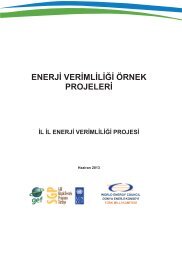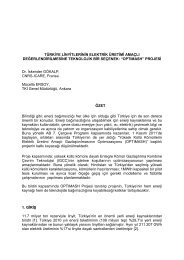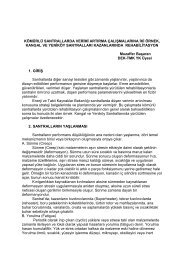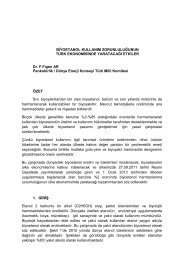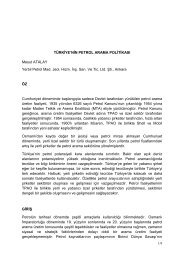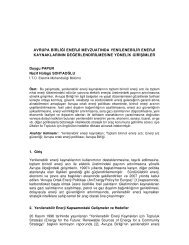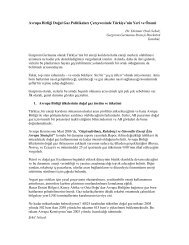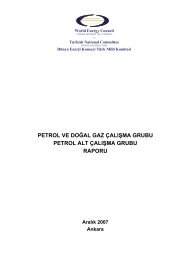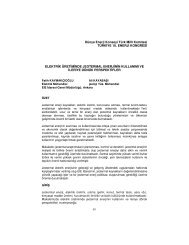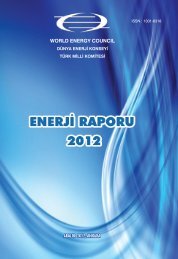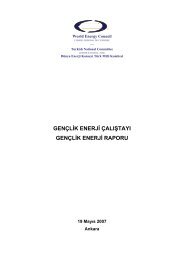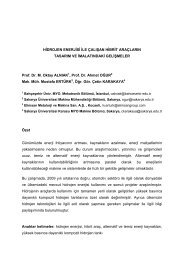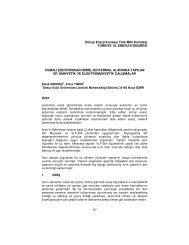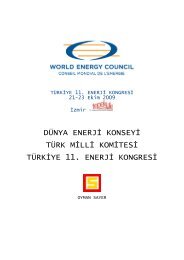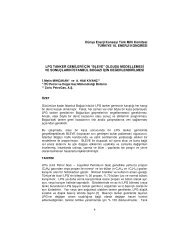Interconnectivity Benefits and Challenges
Executive Summary - World Energy Council
Executive Summary - World Energy Council
You also want an ePaper? Increase the reach of your titles
YUMPU automatically turns print PDFs into web optimized ePapers that Google loves.
able energy for the<br />
<strong>Interconnectivity</strong>:<br />
<strong>Benefits</strong> <strong>and</strong><br />
<strong>Challenges</strong><br />
World Energy Council<br />
For sustainable energy.
<strong>Benefits</strong> <strong>and</strong> <strong>Challenges</strong><br />
Officers of the World Energy Council<br />
Pierre Gadonneix<br />
Chair<br />
Francisco Barnés de Castro<br />
Vice Chair, North America<br />
Norberto Franco de Medeiros<br />
Vice Chair, Latin America/Caribbean<br />
Richard Drouin<br />
Vice Chair, Montréal Congress 2010<br />
C.P. Jain<br />
Chair, Studies Committee<br />
Younghoon David Kim<br />
Vice Chair, Asia Pacific & South Asia<br />
<strong>Interconnectivity</strong>: <strong>Benefits</strong> <strong>and</strong> <strong>Challenges</strong><br />
World Energy Council<br />
Copyright © 2010 World Energy Council<br />
All rights reserved. All or part of this publication may be used or<br />
reproduced as long as the following citation is included on each<br />
copy or transmission: „Used by permission of the World Energy<br />
Council, London, www.worldenergy.org‟<br />
Published 2010 by:<br />
World Energy Council<br />
Regency House 1-4 Warwick Street<br />
London W1B 5LT United Kingdom<br />
ISBN: 978-0-946121-39-7<br />
Jorge Ferioli<br />
Chair, Programme Committee<br />
Marie-José Nadeau<br />
Vice Chair, Communications & Outreach Committee<br />
Abubakar Sambo<br />
Vice Chair, Africa<br />
Johannes Teyssen<br />
Vice Chair, Europe<br />
Abbas Ali Naqi<br />
Vice Chair, Special Responsibility for Middle East &<br />
Gulf States<br />
Graham Ward, CBE<br />
Vice Chair, Finance<br />
Zhang Guobao<br />
Vice Chair, Asia<br />
Christoph Frei<br />
Secretary General
<strong>Interconnectivity</strong>: <strong>Benefits</strong> <strong>and</strong> <strong>Challenges</strong> World Energy Council<br />
1<br />
Foreword<br />
One of the major factors affecting world<br />
development is energy. Final energy use has<br />
increased globally by nearly 20 percent in the<br />
last 10 years. The electric energy represents<br />
about one third of the total world energy<br />
consumption, <strong>and</strong> its production accounts for<br />
40-50% of anthropogenic CO 2 emissions.<br />
Consumption of electricity grows 1.5 times<br />
faster than total energy consumption. This is<br />
supported not only by power generating plants<br />
but also by the strong Transmission &<br />
Distribution (T&D) systems which carry<br />
economic, safe <strong>and</strong> reliable supplies of<br />
electricity to industrial, commercial <strong>and</strong><br />
residential clients. At the same time, still around<br />
1.6 billion people in the world have no access to<br />
electricity. Various studies have highlighted the<br />
correlation between use of electricity <strong>and</strong> social<br />
development/quality of life <strong>and</strong> the role of<br />
“interconnectivity” in achieving affordable<br />
supplies by interconnecting individual plants,<br />
regions, nations <strong>and</strong> even continents. This role<br />
is becoming of paramount importance to future<br />
development of the electricity sector.<br />
WEC decided to set up a Task Force on<br />
<strong>Interconnectivity</strong> in 2008 <strong>and</strong> after two years of<br />
intensive research <strong>and</strong> analysis, a report was<br />
produced. It includes seven chapters which<br />
cover the topics most pertinent to<br />
interconnectivity. A lot of ground work has been<br />
done by the Task Force to arrive at a<br />
comprehensive report, produced using detailed<br />
contributions of the Task Force members.<br />
These individual contributions are included in<br />
the full report <strong>and</strong> its annexes <strong>and</strong> are available<br />
in electronic format only on the WEC website at<br />
www.worldenergy.org<br />
Each member of the Task Force had to cover a<br />
certain issue <strong>and</strong> all received contributions<br />
were reviewed <strong>and</strong> agreed at the Task Force<br />
meetings.<br />
In this Executive Summary only main issues,<br />
conclusions <strong>and</strong> recommendations are included<br />
with the main purpose to bring to the readers‟<br />
attention the key role of interconnectivity <strong>and</strong><br />
the associated socio-economic, environmental,<br />
financial <strong>and</strong> regulatory aspects that must be<br />
taken into account for successful<br />
interconnection projects.<br />
For me, it has been an honour to serve as the<br />
Study Director during these two years <strong>and</strong> work<br />
together with the Task Force comprising over<br />
30 members from nearly 25 countries. I will<br />
cherish the memories of our stimulating<br />
meetings, the exchanges of information, points<br />
of view <strong>and</strong> even disputes – but what is most<br />
important - the amicable relations established<br />
between us going far beyond “interconnectivity”.<br />
I want to thank all Task Force members for their<br />
valuable <strong>and</strong> highly professional contributions<br />
<strong>and</strong> for their friendship. Special thanks to Elena<br />
Nekhaev, WEC Director of Programmes, for her<br />
continuous guidance <strong>and</strong> assistance <strong>and</strong> her<br />
contribution to the finalisation of the report.<br />
Aless<strong>and</strong>ro Clerici, Task Force Director,<br />
Assistant to the President, ABB Italy
<strong>Interconnectivity</strong>: <strong>Benefits</strong> <strong>and</strong> <strong>Challenges</strong> World Energy Council<br />
2<br />
Task Force Membership<br />
Chair: Mr. Elías Velasco García<br />
Director: Dr. Aless<strong>and</strong>ro Clerici<br />
Members:<br />
Algeria Mr. Abdelmadjid Benbellil Sonelgaz<br />
Austria Mr. Dieter Meyer VERBUND<br />
China Ms. Cheng State Grid Corp.<br />
Colombia Mr. José Vicente Camargo Cocier<br />
Egypt<br />
Mr. Jorge Mauricio Areiza<br />
Dr. Dalal Helmi<br />
France Mr. Xavier Hurbin Areva<br />
ISA<br />
Egyptian Electricity Transmission<br />
Company<br />
India Mr. A. K. Asthana Central Electricity Authority<br />
Mr. Ravi N. Nayak<br />
Mr. Sridhar Samudrala<br />
Power Grid India<br />
WADE<br />
Indonesia Ir. Nur Pamudi PT PLN<br />
Irel<strong>and</strong> Mr. Kieran O'Brien WEC Honorary Officer<br />
Italy Mr. Enrico Carlini TERNA<br />
Mr. Massimo Ceccariglia<br />
Ms. Francesca Massara<br />
Mr. Bruno Cova<br />
TERNA<br />
TERNA<br />
CESI SpA<br />
Japan Mr. Taro Nakazawa TEPCO<br />
Jordan Dr. Hisham Khatib Ministry of Energy<br />
Mexico Dr. Hector Sarmiento Uruchurtu Gerencia de Transmision<br />
Norway Mr. Lars Vormedal Statnett<br />
Romania Mr. Gal Stelian-Iuliu-Alex<strong>and</strong>ru Romanian Power Grid Co.<br />
Mr. Florin Balasiu<br />
South Africa Mr. Pat Naidoo WESTCOR<br />
Romanian Power Grid Co.<br />
Spain Mr. Juan Alvarez Gonzalez Club Espanol de la Energia<br />
Mr. Eloy Alvarez Pelegry<br />
Mr. Juan Manuel Rodriguez<br />
Ms. Olivia Alonso Garcia<br />
Union Fenosa<br />
Sweden Mr. Staffan Mared Vattenfall<br />
Switzerl<strong>and</strong> Mr. Alex<strong>and</strong>er Mondovic SwissGrid<br />
Red Eléctrica de España<br />
Red Eléctrica de España<br />
Thail<strong>and</strong> Dr. Sarawut Kaewtathip Ministry of Energy<br />
Turkey Ms. Gül Okan TEİAŞ<br />
USA Mr. Michael Valocchi IBM<br />
World Energy Council:<br />
Ms. Elena Nekhaev<br />
International Organisations: Mr. ColinRay CIGRE
<strong>Interconnectivity</strong>: <strong>Benefits</strong> <strong>and</strong> <strong>Challenges</strong> World Energy Council<br />
3<br />
Executive Summary<br />
1. INTRODUCTION<br />
Access to affordable <strong>and</strong> reliable electricity<br />
supplies is a basic prerequisite for economic<br />
<strong>and</strong> social development, prosperity, health,<br />
education <strong>and</strong> all other aspects of modern<br />
society. Electricity can be generated both near<br />
<strong>and</strong> far from the consumption areas as<br />
transmission lines, grid interconnections <strong>and</strong><br />
distribution systems can transport it to the final<br />
consumer.<br />
In the vast majority of countries, the electricity<br />
sector used to be owned <strong>and</strong> run by the state.<br />
The wave of privatisation <strong>and</strong> market<br />
introduction in a number of countries <strong>and</strong><br />
regions which started in the late 1980‟s has in<br />
many cases involved unbundling of generation<br />
from transmission <strong>and</strong> distribution (T&D). This<br />
has nearly everywhere exposed transmission<br />
“bottlenecks” limiting the development of wellfunctioning<br />
markets.<br />
Transmission on average accounts for about<br />
10-15% of total final kWh cost paid by the enduser<br />
but it is becoming a key issue for effective<br />
operation of liberalised markets <strong>and</strong> for their<br />
further development. An integrated <strong>and</strong><br />
adequate transmission infrastructure is of<br />
utmost importance for ensuring the delivery of<br />
the most competitively priced electricity,<br />
including externalities, to customers, both near<br />
<strong>and</strong> far from the power generating facilities.<br />
The Task Force has been covering all the main<br />
aspects of interconnections <strong>and</strong> results of their<br />
research are presented in seven main chapters:<br />
Chapter 1:<br />
Chapter 2:<br />
Chapter 3:<br />
Chapter 4:<br />
is an introductory part explaining<br />
the background <strong>and</strong> objectives. It<br />
also sets out the main issues <strong>and</strong><br />
discusses electricity vs primary<br />
energy (gas, coal) transport<br />
presents an overview of the main<br />
types of interconnections,<br />
including bulk power<br />
transmission over long distances,<br />
integrated grids, integration of<br />
renewables, feeding of isolated<br />
low load areas, CO2 impacts on<br />
competitiveness of various<br />
options<br />
discusses the present state <strong>and</strong><br />
possible development of various<br />
T&D system components <strong>and</strong><br />
technologies, including “smart<br />
transmission grids” <strong>and</strong> the<br />
interaction between different<br />
technologies<br />
presents current status <strong>and</strong><br />
trends around the world, national,<br />
sub-regional <strong>and</strong> regional interconnections,<br />
including existing,<br />
under construction <strong>and</strong> planned,<br />
trends, basic techno-economic,<br />
social <strong>and</strong> environmental drivers<br />
<strong>and</strong> issues, in the European<br />
Union, CIS, South-North<br />
Mediterranean Interconnection,<br />
Black Sea <strong>and</strong> the Caspian,<br />
Middle East & the Gulf, Australia<br />
North, Central <strong>and</strong> South<br />
America <strong>and</strong> Sub-Saharan Africa<br />
<strong>and</strong> Asia.
4<br />
<strong>Interconnectivity</strong>: <strong>Benefits</strong> <strong>and</strong> <strong>Challenges</strong> World Energy Council<br />
Chapter 5:<br />
Chapter 6:<br />
identifies key considerations for<br />
interconnections, such as<br />
markets, political, regulatory <strong>and</strong><br />
legal aspects, business<br />
governance <strong>and</strong> models,<br />
barriers, economics, risks <strong>and</strong><br />
finance, including capacity<br />
allocation <strong>and</strong> cost sharing,<br />
environmental, social, permitting<br />
<strong>and</strong> sustainability considerations,<br />
including security of supply <strong>and</strong><br />
limits to the extension of<br />
synchronously interconnected<br />
systems <strong>and</strong> issues associated<br />
with interconnections of small<br />
countries into a large grids,<br />
human resources, technical<br />
expertise <strong>and</strong> skills, roles <strong>and</strong><br />
responsibilities of different<br />
stakeholders<br />
outlines key trends from the<br />
assessment of a few selected<br />
inter-connection projects<br />
available energy transport technologies must be<br />
evaluated considering also the environmental<br />
impact of energy transport <strong>and</strong> not only of<br />
electricity generation. This requires a solid<br />
knowledge of the possible transport solutions,<br />
regional mapping of available resources <strong>and</strong><br />
sound methodologies for evaluation.<br />
The general related issues include:<br />
<br />
<br />
1.6 billion people in the world do not have<br />
access to electricity;<br />
role of environment in production <strong>and</strong><br />
transmission of energy;<br />
increase of electricity penetration rate:<br />
increase of electricity produced by gas;<br />
<br />
<br />
availability of cheap hydro resources, oil<br />
associated gas <strong>and</strong> marginal gas reserves<br />
with potential use far beyond the borders of<br />
the country where the resource is located;<br />
availability of high potential wind <strong>and</strong> solar<br />
resources.<br />
Chapter 7:<br />
presents conclusions <strong>and</strong><br />
recommendations<br />
The transport of energy either as primary<br />
energy or in form of electricity has been often<br />
compared in projects where natural gas was the<br />
primary energy resource <strong>and</strong> the choice was<br />
either to produce electricity locally or transport<br />
the gas to distant power stations. When<br />
sustainable development is considered, the use<br />
of all available energy resources should be the<br />
objective, both those transportable in form of<br />
mass (gas, coal, oil) <strong>and</strong> those that require local<br />
conversion to electricity (hydro, wind, solar). All<br />
2. MAIN TYPES OF INTERCONNECTIONS<br />
2.1 Interconnections in Integrated<br />
Grids<br />
It is not always easy to identify interconnections<br />
in grids. Today, all countries have an electrical<br />
grid (mostly a transmission one) <strong>and</strong> there are a<br />
lot of cases where the national grids touch each<br />
other in some points <strong>and</strong> therefore the grids of<br />
the world are already interconnected to some<br />
extend on a continental scale.
<strong>Interconnectivity</strong>: <strong>Benefits</strong> <strong>and</strong> <strong>Challenges</strong> World Energy Council<br />
5<br />
The crucial question is for what purpose<br />
(mutual operational help, trade, generation or<br />
load), by which means (in terms of technology)<br />
<strong>and</strong> how well (in terms of capacity) the grids are<br />
interconnected <strong>and</strong> some criteria can be<br />
determined to enable categorizing different<br />
types of interconnections<br />
<br />
First, electrical links which are only<br />
occasionally used should not be<br />
considered interconnections.<br />
(i.e. lack of secondary control in one of the<br />
grids) are different, DC links are the only<br />
solution, prevent propagation of disturbances<br />
from one grid to the other <strong>and</strong> can be realized<br />
without a deeper analyzes of grids‟ operational<br />
characteristics. En example for this type of<br />
interconnection could be the envisaged<br />
interconnection of the ENTSO-E grid with the<br />
grid of IPS/UPS (CIS – Commonwealth of<br />
Independent States encompassing Russia <strong>and</strong><br />
the states around it)<br />
<br />
Second, the geographical location of grids<br />
has to be taken into account.<br />
Submarine interconnection of separately<br />
operated grids<br />
<br />
<br />
<br />
Third, the function of the interconnection<br />
is within an already synchronously<br />
operated grid or between two grids which<br />
are operated independently?<br />
Fourth, is the interconnection a<br />
synchronous (i.e. alternating current - AC)<br />
or asynchronous (i.e. direct current – DC)<br />
one?<br />
Fifth, is the interconnection a part of an<br />
ultra high voltage structure overlaying the<br />
existing grids?<br />
Terrestrial interconnection of separately<br />
operated grids<br />
In case of two well developed grids which are<br />
not operated synchronously, interconnectors<br />
can be put into operation to enable significant<br />
mutual support <strong>and</strong> power exchange <strong>and</strong> both<br />
AC <strong>and</strong> DC links are worth considering.<br />
However, if the rated frequency, the margins of<br />
frequency regulation or the balancing means<br />
When the two grids which are not operated<br />
synchronously are separated by a significant<br />
natural barrier like a sea with a considerable<br />
distance between the shores, they can be<br />
interconnected only by using the DC<br />
technology.<br />
An example of interconnection of 2 large grids<br />
is the one between ENTSO-E (continental part<br />
of Europe) <strong>and</strong> NORDEL (Sc<strong>and</strong>inavia) <strong>and</strong><br />
several DC interconnectors are already<br />
realized.<br />
The DC interconnector between the ENTSO-E<br />
grid (France) <strong>and</strong> the grid of Great Britain is an<br />
example for the submarine interconnection of a<br />
large <strong>and</strong> a relatively small grid. Other<br />
examples are e.g. the connection of Balearic<br />
Isl<strong>and</strong>s to the Iberian Peninsula <strong>and</strong> of Sardinia<br />
to the Italian Peninsula.<br />
The DC interconnector between Great Britain<br />
<strong>and</strong> Northern Irel<strong>and</strong> is an example of linking<br />
two grids of relatively small size.
6<br />
<strong>Interconnectivity</strong>: <strong>Benefits</strong> <strong>and</strong> <strong>Challenges</strong> World Energy Council<br />
Firm <strong>and</strong> weak AC extensions of a grid<br />
If a relatively small well developed grid needs to<br />
be interconnected with a large neighbouring<br />
well developed grid, in most cases a<br />
synchronous (AC) solution will be implemented<br />
<strong>and</strong> the operational st<strong>and</strong>ards of the smaller<br />
grid will have to be upgraded in order to fully<br />
comply with the st<strong>and</strong>ards of the integrated<br />
grid. An example is the synchronous<br />
interconnection of the ENTSO-E grid with<br />
Turkey under implementation..<br />
If the small well developed grid doesn‟t need to<br />
be fully integrated into the neighbouring well<br />
developed grid, the synchronous solution for<br />
the interconnection still may be used, but it will<br />
be a weak one <strong>and</strong> the small grid won‟t<br />
overtake the operational st<strong>and</strong>ards of the grid.<br />
Disturbances originating in the small grid won‟t<br />
have a significant impact on the grid <strong>and</strong> the<br />
single interconnector will be disconnected by<br />
the protection system. An example is the link<br />
between the ENTSO-E grid <strong>and</strong> the grid of<br />
Maghreb countries (Morocco, Algeria <strong>and</strong><br />
Tunisia). In order to ensure a safe operation of<br />
this extension an “Interface Cooperation<br />
Agreement between the Interconnected<br />
Networks of Morocco, Algeria, Tunisia <strong>and</strong><br />
Spain related to Conditions for the Networks<br />
Synchronous Operation” was signed<br />
AC interconnection within a synchronous<br />
grid<br />
Every new transmission line between any two<br />
countries <strong>and</strong> an internal new transmission line<br />
within any country is a kind of interconnector to<br />
increase the interconnectivity of the existing<br />
grids. Two categories of AC interconnectors<br />
can be differentiated: overhead <strong>and</strong><br />
underground lines(or lines which are only<br />
partially built with underground cables). Some<br />
recent examples for this last case are in Italy<br />
<strong>and</strong> Austria.<br />
DC interconnection within an integrated<br />
synchronous grid<br />
Two countries may be geographically close to<br />
one another <strong>and</strong> operated within the same<br />
synchronous grid, yet still only weakly or not<br />
interconnected.<br />
An example for a relatively weak<br />
interconnection is the one between France <strong>and</strong><br />
Spain where an additional interconnector is<br />
envisaged as an underground DC line for<br />
environmental reasons.<br />
The planned DC submarine interconnections<br />
between Italy <strong>and</strong> Croatia <strong>and</strong> Montenegro are<br />
examples for reinforcing a synchronously<br />
operated ENTSO-E grid.<br />
Interconnection to isolated large production<br />
units<br />
To connect that kind of production, AC <strong>and</strong> DC<br />
interconnectors may be envisaged. AC lines are<br />
mainly eligible if a terrestrial solution is feasible<br />
<strong>and</strong> there are examples for this in Brazil <strong>and</strong><br />
China. Large off-shore wind farms, such as<br />
envisaged in the North Sea, which will have to<br />
be connected to their neighbouring grids (<strong>and</strong><br />
possibly to one another) by the means of DC<br />
submarine interconnectors, are other examples.
<strong>Interconnectivity</strong>: <strong>Benefits</strong> <strong>and</strong> <strong>Challenges</strong> World Energy Council<br />
7<br />
Overlaying interconnection<br />
If the amount of power to be exchanged <strong>and</strong><br />
the distances to be covered are of such an<br />
extent that existing transmission lines cannot<br />
solve the problem, an overlaying higher voltage<br />
level grid can be considered <strong>and</strong> it may consist<br />
of AC <strong>and</strong>/or DC lines <strong>and</strong> a clear example is<br />
China with both AC 1000kV <strong>and</strong> +/-800 kV DC<br />
Examples in the past have been the 400 kV or<br />
500kV AC grids superimposed to the 245 kV<br />
system in Europe <strong>and</strong> US respectively <strong>and</strong> the<br />
700-765 AC grid in Russia <strong>and</strong> other CIS<br />
countries <strong>and</strong> in US<br />
There are visionary projects to realize a Super<br />
Grid in Europe encompassing the territory<br />
of ENTSO-E <strong>and</strong> NORDEL countries as well as<br />
Great Britain <strong>and</strong> Irel<strong>and</strong>, <strong>and</strong> connecting them<br />
with off-shore wind farms all around Europe,<br />
<strong>and</strong> with North Africa where Concentrated Solar<br />
Power plants could be installed in the future.<br />
Such a Super Grid could be even extended to<br />
Near East, Middle East <strong>and</strong> Caucasus regions.<br />
2.2 Bulk Power Transmission<br />
With “bulk transmission” it is intended the<br />
transport of “large amount of power” over long<br />
distances <strong>and</strong> 2 main types are considered:<br />
-OHTLs/systems<br />
-sea crossings <strong>and</strong> cable systems<br />
The values of "large power" <strong>and</strong><br />
"large distance" have got a substantial<br />
increase, following development of the electrical<br />
components.In this chapter the power transfer<br />
of around 1000 MW <strong>and</strong> above is termed bulk<br />
electricity transmission.<br />
Overhead lines longer than about 500<br />
km require shunt compensation <strong>and</strong> series<br />
compensation to a degree that depends on<br />
network characteristics(see section 3).<br />
HVDC represents today an attractive<br />
alternative. For capacity exceeding 1000 MW;<br />
bi-pole systems typically at ±500 kV level are<br />
today a st<strong>and</strong>ard solution (e.g. Three Gorges in<br />
China), but ±800 kV level is under<br />
commissioning in China.<br />
Bulk energy transmission with over-head<br />
transmission lines (OHTL’s)<br />
The cost of the bulk transmission system can<br />
be split mainly into:<br />
overhead line cost<br />
terminal cost (converter stations for HVDC,<br />
substations <strong>and</strong> compensation substations for<br />
HVAC)<br />
capitalized cost of losses<br />
The choice between HVAC or HVDC depends<br />
mainly on the capacity <strong>and</strong> transmission<br />
distance. Generally HVDC is considered less<br />
expensive when applied to capacity over 1000<br />
MW <strong>and</strong> distances over around 800 km. This is<br />
due to the higher cost of the terminal<br />
substations <strong>and</strong> lower cost of the line that apply<br />
to HVDC<br />
The cost of a transmission system clearly<br />
depends on local costs <strong>and</strong> on environmental
8<br />
<strong>Interconnectivity</strong>: <strong>Benefits</strong> <strong>and</strong> <strong>Challenges</strong> World Energy Council<br />
<strong>and</strong> logistic conditions; differences of around 1<br />
to 2 for the same type of system can be found<br />
in different regions .A case by case study is<br />
therefore indispensable to get precise data .In<br />
addition, in the present turbulent situation for<br />
raw materials costs, it is difficult to define even<br />
ranges which could be considered valid for few<br />
years<br />
Fig.1 provides the cost of the transferred<br />
energy by changing the amount of power <strong>and</strong><br />
the OHTL length,. reports a typical case study<br />
for a medium value of cost of losses.<br />
For 1000 MW , the cost of transmission<br />
over 1000 km could be in the range 10-20%of<br />
the total energy cost at the load side. The<br />
same10-20% applies to 3000 MW transferred<br />
over 2000 km<br />
With reference to l<strong>and</strong> transmission ,in the<br />
past various projects have been<br />
implemented such as the James Bay in<br />
Canada, the Itaipù <strong>and</strong> the Norte - Sul<br />
interconnection in Brazil, the Guri in Venezuela,<br />
Inga – Shaba in Congo ( HVDC Line with its<br />
1750 km), Cahora Bassa-Apollo in<br />
Mozambique/South Africa <strong>and</strong> Three<br />
Gorges <strong>and</strong> other projects in China <strong>and</strong> India.<br />
The increasing penalisation of electricity<br />
production from fossil fuel plants can foster the<br />
use of remote hydro <strong>and</strong> other RES with<br />
respect to coal/gas power plants close to the<br />
load areas.With CO2 penalties above 25<br />
€/tonne, transmission of energy from hydro<br />
plants even from distances of more than 2500<br />
km is less expensive compared to production<br />
locally using gas or coal plants <strong>and</strong> even with<br />
low prices for gas <strong>and</strong> coal (corresponding to<br />
the oil price around 45US$/barrel)<br />
Another example of using available resources is<br />
given by Angola in sub-Saharan Africa. Existing<br />
proven gas reserves (~43 Gm 3 ) is mostly<br />
associated gas (gas produced as a by-product<br />
of oil production that is almost 85 % flared. The<br />
commercial exploitation of this gas would yield<br />
many benefits of both economic <strong>and</strong><br />
environmental nature <strong>and</strong> schemes have been<br />
studied to produce electricity with TG plants up<br />
to about 2000 MW <strong>and</strong> to transport this very<br />
cheap electricity to distances over 2000 km.<br />
For the use of the huge hydro resources of the<br />
Congo river a first expansion of the Inga power<br />
station was planned for around 4000 MW with<br />
transmission of the generated electricity with<br />
HVDC lines down to South Africa through<br />
Angola, Namibia <strong>and</strong> Botswana with a total<br />
length over 3000 km ;the Gr<strong>and</strong> Inga Project<br />
with the possible transmission of cheap<br />
30,000÷60,000 MW from INGA up to Egypt<br />
(5000÷6000 km) or even Europe has been<br />
proposed many times in the last 25 years.
<strong>Interconnectivity</strong>: <strong>Benefits</strong> <strong>and</strong> <strong>Challenges</strong> World Energy Council<br />
9<br />
A third example is the system under<br />
commissioning in China to convey more than<br />
6000 MW per circuit with HVDC at +/- 800kV<br />
from areas having cheap hydro generation<br />
costs. Always in China possible 3500 km of +/-<br />
1000 kV UHVDC systems to convey power of<br />
around 15000 MW from wind remote farms are<br />
under study.<br />
Bulk power transmission involving sea<br />
crossings <strong>and</strong> cables<br />
The present limits for bulk power transmission<br />
are posed by voltage <strong>and</strong> power limits of<br />
cables(see chapter 3).For power ratings above<br />
around 1000 MW it is not possible to avail<br />
important scale effects as in the case of OHTL's<br />
.because it is necessary to duplicate or triplicate<br />
the parallel cable circuits.<br />
For l<strong>and</strong> or sea distances of more than 60-100<br />
km it is m<strong>and</strong>atory the use of DC. In l<strong>and</strong> areas<br />
characterised by serious concerns for the<br />
environment the adoption of DC<br />
interconnections via cables has been already<br />
agreed in some cases (e.g. Spain France<br />
interconnection <strong>and</strong> merchant lines in Italy<br />
connecting Italy to France <strong>and</strong> Switzerl<strong>and</strong> with<br />
cable lengths exceeding 160 km) .With the<br />
development of VSC's <strong>and</strong> the XLPE cheap<br />
cables/joints it is envisaged an extension of<br />
these applications<br />
The NorNed (Norway-Nederl<strong>and</strong>s) scheme at<br />
+/- 450 kV carrying around 700 MW is at<br />
present the longest cable connection (580 km<br />
world record).<br />
It is under final commissioning the SAPEI<br />
(Sardinia-Italian peninsula) for 1000 MW at +/-<br />
500 kV <strong>and</strong> 435 km long <strong>and</strong> sea depth is up to<br />
around 1600 m(world record).<br />
Bulk cable transmission /interconnections<br />
exceeding 1000 MW <strong>and</strong> 500 km are therefore<br />
becoming a reality <strong>and</strong> 2000 MW DC crossings<br />
are under study in the Adriatic Sea. The<br />
possible development of large wind farms in the<br />
Baltic Sea or of solar plants in Africa (eg<br />
DESERTEC project) will imply substantial<br />
increase in bulk undersea transmission.<br />
With reference to range of costs, are still valid<br />
the considerations of the previous paragraph<br />
(case by case analysis).Just for reference, from<br />
published data the OVN cost of the 1000 MW-<br />
435 km Sardinia Italy connection is some 700<br />
million Euros.<br />
2.3 Feeding of isolated load areas with no<br />
local energy resources<br />
Electricity supply of isolated areas having<br />
initial loads of 5-15 MW100-400 MW<br />
from isolated plants<br />
In many developing regions, per capita<br />
consumption of electricity <strong>and</strong> per cent of<br />
population having access to electricity are<br />
extremely low. The possible main electrical load<br />
centres in these regions may be scattered over<br />
many areas <strong>and</strong> the initial load is in the range of<br />
few MW with different growth rates.<br />
In these situations, local diesel generation for<br />
each load centre is normally implemented fed<br />
by fuel oil transported over long distances.
10<br />
<strong>Interconnectivity</strong>: <strong>Benefits</strong> <strong>and</strong> <strong>Challenges</strong> World Energy Council<br />
Installation of a single generation plant feeding<br />
different load centres can, on the contrary, be<br />
cost competitive due to the economy of scale<br />
on investment cost <strong>and</strong> O&M costs <strong>and</strong> due to<br />
the higher efficiency of larger units. Beside the<br />
economy of scale one has to carefully consider<br />
the levelling of the load diagram <strong>and</strong> reduction<br />
of the peak load, resulting from load diversity<br />
when the different dem<strong>and</strong> areas are connected<br />
to the single source.<br />
Renewables, solar & wind could be considered<br />
for isolated areas as alternatives to local diesel<br />
generation, although some storage or back-up<br />
facilities would be necessary.<br />
the desert 500 km far from main grid..<br />
Electricity supply of 100-400 MW<br />
from isolated plants<br />
The same concept is valid also for consumption<br />
areas having dem<strong>and</strong> requirements of some<br />
hundreds of MW.<br />
Fig. 2<br />
With respect to concentrated generation the<br />
comparison still holds if one considers, as<br />
power source, an interconnected system, far<br />
from loads.<br />
With initial small loads of 5-10 MW an energy<br />
transmission from 250-450 km is more<br />
convenient than local diesel generation; this<br />
even with the minimum oil price considered <strong>and</strong><br />
equal to 35 $/bl. Clearly higher values of oil<br />
price <strong>and</strong> of load growth rates increase the<br />
advantage of transmission versus local<br />
generation.<br />
The 230 kV voltage level becomes competitive<br />
versus the 138 kV one, for larger initial loads<br />
(above around 10 MW) <strong>and</strong> larger distances.<br />
An example of possible utilization of cheap<br />
power that could be economically transferred to<br />
hundreds of km for some tens of MW is the<br />
Saida-Naama-Bechar 230 kV system in Algeria.<br />
A single overhead transmission line with<br />
appropriate RPC systems is feeding villages in<br />
With diagrams plotted on the basis of local cost<br />
conditions (Fig 2) it is easily defined the local<br />
cost of imported energy for possible different<br />
values of generation cost from plants far from<br />
consumption areas. In particular. Fig.2 shows<br />
the transmission cost of kWh for power level<br />
from 100 to 400 MW <strong>and</strong> for distances from 200<br />
to 600 km.<br />
Clearly the interest is to use remote cheap<br />
energy; this may be the case for utilization of<br />
flared gas or of fields exhibiting marginal gas<br />
reserves.<br />
Transport of gas requires very large flow to be<br />
economic when the dem<strong>and</strong> of power is in the
<strong>Interconnectivity</strong>: <strong>Benefits</strong> <strong>and</strong> <strong>Challenges</strong> World Energy Council<br />
11<br />
range of 100 MW to 400 MW .This dynamic of<br />
the gas transport cost could cause to disregard<br />
gas fields exhibiting marginal reserves. An<br />
example of such a development is the Aguaytia<br />
Project in the Jungle of Peru <strong>and</strong> the field has<br />
recoverable reserves estimated at 12 Gm3 of<br />
gas .The generating capacity of the plant is 160<br />
MW <strong>and</strong> an electric power line rated 220 kV<br />
<strong>and</strong> 400km long connects the power plant to<br />
the main loads.<br />
The same concept is valid also for consumption<br />
areas having dem<strong>and</strong> requirements of some<br />
hundreds of MW.<br />
The new VSC HVDC Technology transmission<br />
could be an interesting option for the<br />
investigated cases <strong>and</strong> should be considered to<br />
complete the picture. .<br />
2.4 Supply to isl<strong>and</strong>s<br />
When the isl<strong>and</strong> required load is of<br />
small/medium size, the use of gas/oil pipelines<br />
becomes uneconomical <strong>and</strong> the common<br />
choice for electricity supply is the use of local<br />
generation fed by imported fuel. The electricity<br />
transport from a hub area as an alternative to<br />
local generation is however of interest in very<br />
many cases <strong>and</strong> the transport could fulfil an<br />
increase in power dem<strong>and</strong> at the isl<strong>and</strong> or a<br />
combination of this with substitution of old<br />
plants<br />
Gas turbine combined-cycle plant (CCGT),<br />
gasoil fuelled<br />
Steam Turbine Plant (ST) oil fuelled.<br />
As to the “hub” generation, it is assumed a<br />
system with large use of combined cycle units<br />
of 400MW.<br />
For the submarine transmission, depending on<br />
the concerned distance, the most suitable<br />
technology between Alternating Current (AC)<br />
<strong>and</strong> Direct Current (DC) has been considered<br />
for each distance. Figure 3 shows how the<br />
electricity delivery via submarine transmission<br />
results economically competitive over all the<br />
distance range considered even with the<br />
low values for local oil <strong>and</strong> gasoil; higher<br />
values would increase the competitiveness.<br />
Interconnections would reduce the CO2<br />
emissions, increasing its economic<br />
advantage as a function of cost of CO2.<br />
Practical examples are the proposals made to<br />
supply the isl<strong>and</strong> of Cyprus in the<br />
Mediterranean sea with electricity from Turkey<br />
(hydro <strong>and</strong> high efficiency combined cycle<br />
plants) or Malta from Italy.<br />
Power transfer in the range 200 MW to 500 MW<br />
has been taken into account <strong>and</strong> two technical<br />
alternatives have been analysed for local<br />
generation which considers unit size in the<br />
range 100 to 250 MW
12<br />
<strong>Interconnectivity</strong>: <strong>Benefits</strong> <strong>and</strong> <strong>Challenges</strong> World Energy Council<br />
Fig. 3<br />
large power flows are generated from sparsely<br />
populated areas to load centers. For wind<br />
power, currently the most exploitable new<br />
renewable energy source in many nations,<br />
large offshore wind farms are foreseen, when<br />
the cheaper l<strong>and</strong>-based wind power sites<br />
already are exploited as far as possible.<br />
While investments in renewable power<br />
increase, licensing issues for transmission may<br />
in many cases determine the expansion rate<br />
possible for the renewable energy <strong>and</strong><br />
streamlining the permit process for power grid<br />
is consequently a key issue f.<br />
2.5 Integration Of Concentrated Bulk RES<br />
Generation<br />
The use of new renewable energy sources for<br />
electricity generation is growing rapidly <strong>and</strong><br />
worldwide. The claims on the existing<br />
transmission <strong>and</strong> distribution systems, to be<br />
able to connect <strong>and</strong> transfer the new generation<br />
plants are enormous. To a large extent, this<br />
expansion consists of wind power, but<br />
preliminary studies also show that CSP<br />
(Concentrated Solar Power) <strong>and</strong> wave power<br />
could be significant energy sources in<br />
the future.<br />
Electricity generation plants using wind or solar<br />
as a primary energy source will grow in size to<br />
become economically attractive. For wind<br />
power, this has been demonstrated by growing<br />
wind turbines, which are set up in groups to<br />
aggregate wind farms.L<strong>and</strong> areas that are<br />
available usually for RES generation are far<br />
from the areas where energy is consumed <strong>and</strong><br />
The growing amounts of wind power in the<br />
different countries are dem<strong>and</strong>ing new technical<br />
solutions for concentrated intermittent<br />
transmission of electricity between the existing<br />
national transmission systems which have to<br />
interact in order to equalize local variations in<br />
wind generation over large areas to allow<br />
overall optimization of the reserves in the<br />
interconnected electricity systems.<br />
The internationally broad plans for offshore<br />
wind development in large concentrated wind<br />
farms dem<strong>and</strong> the development of new offshore<br />
network technologies such as controllable<br />
meshed offshore cable networks that connects<br />
to a number of existing national transmission<br />
systems. On the other h<strong>and</strong>, the integration of<br />
onshore or offshore wind plants in the electrical<br />
systems have a direct implication on the needs<br />
of stronger interconnection capacity as well as<br />
other smart measures (storage, dem<strong>and</strong> side<br />
management, electrical vehicles) providing a<br />
smoothing effect on the wind resource with<br />
respect to dem<strong>and</strong>.
<strong>Interconnectivity</strong>: <strong>Benefits</strong> <strong>and</strong> <strong>Challenges</strong> World Energy Council<br />
13<br />
Main types of interconnections linked with<br />
renewables<br />
The expansion plans for renewables<br />
are dem<strong>and</strong>ing new techniques which can<br />
meet the need for controlling the intermittent<br />
power flows that this type of power resource<br />
locally creates. As a consequence discussions<br />
of integration of renewables often ends up in<br />
the possibility of developing solutions using<br />
power electronics (HVDC <strong>and</strong> FACTS) that<br />
seems to be able to solve many of the technical<br />
challenges. Some examples with characteristics<br />
are:<br />
Conventional LCC (Line Commuted<br />
Converter) HVDC links is being a well<br />
known solution with above 1000 MW<br />
capacity in cross-border applications<br />
VSC (Voltage Source Converter) HVDC<br />
links, where possible capacity is now at<br />
about 1000 MW of transmission appears to<br />
be realizable at the moment. The favourable<br />
characteristics of active <strong>and</strong> reactive power<br />
controlling capability in the VSC-converter<br />
in parallel with the fact that it dem<strong>and</strong>s no<br />
outer voltage source for its function makes<br />
this solution important in the large scale<br />
integration of renewables. Multi-terminal<br />
interconnections using the VSC technology<br />
are today possible to use in meshed<br />
offshore wind networks interconnecting<br />
several national transmission<br />
systems. These so-called “super grids”<br />
interconnecting asynchronous international<br />
subsystems over long distances, are also<br />
seen as a future opportunity to achieve<br />
intercontinentally linked generation systems<br />
containing a substantial proportion of<br />
renewable energy sources.<br />
FACTS (Flexible AC Transmission<br />
Systems). In order to comply with grid codes<br />
when large integration of renewable<br />
production in networks with varying strength<br />
/ short-circuit power controllable reactive<br />
compensators are used. SVC (Static Var<br />
Compensator) <strong>and</strong> STATCOM (Static<br />
Synchronous Compensator) are both<br />
examples of that kind of equipment. At the<br />
same time, following the dem<strong>and</strong>s from the<br />
grid codes the similar functionality is<br />
developed in the wind power turbines.<br />
International cooperation: the key to<br />
successful integration<br />
In order to succeed in integrating the<br />
large amounts of renewable power in the<br />
existing transmission system, it is essential to<br />
have an international focus. Harmonization of<br />
trade rules for short-<strong>and</strong> long-term exchanges<br />
of electricity between geographical regions is a<br />
key factor.<br />
Regarding planning of new transmission<br />
systems, it is crucial for a successful integration<br />
of renewable energy that long-term plans <strong>and</strong><br />
so called grid codes are made with a sufficient<br />
focus on the cross border flows of electricity<br />
that is needed for total power system<br />
optimization.<br />
Authorities in different countries <strong>and</strong> regions<br />
have an important task of achieving effective<br />
regulatory framework for sufficiently rapid<br />
licensing of new transmission facilities.<br />
Regarding the interconnectivity the different<br />
stakeholders in the Baltic area are considering<br />
the special opportunities given by mixing the
14<br />
<strong>Interconnectivity</strong>: <strong>Benefits</strong> <strong>and</strong> <strong>Challenges</strong> World Energy Council<br />
hydro dominated northern power systems with<br />
the thermal based systems in central Europé<br />
<strong>and</strong> in the UK. Exchanging thermal power<br />
sources with renewables drives the need for<br />
enhanced trade between the two systems<br />
concerning for example regulating services like<br />
reserve-pooling <strong>and</strong> short term balancing as<br />
well as exchanging power day-night.<br />
The systems on either side of interconnections<br />
benefit from the increased interconnectivity as<br />
the security of supply can be kept on a high<br />
level with less total production capacity<br />
installed. In the light of the mentioned<br />
considerations a lot of new interconnections are<br />
discussed beside the ongoing discussions<br />
about future offshore grids that aims to<br />
interconnect many states via multiple HVDC<br />
systems. Awaiting planning results for meshed<br />
offshore grids options many different two-state<br />
transmission projects are discussed or decided<br />
on in the Baltic area.<br />
An ambitious plan for an electricity "super-grid"<br />
in the North Sea has been developed by a<br />
group of 10 leading European companies. Such<br />
a super-grid connecting the UK, Germany <strong>and</strong><br />
Norway is expected to cost €34bn (£30.5bn).<br />
Ideas for a European super-grid have attracted<br />
growing political interest. Last December, nine<br />
European Union member states, including<br />
France, Germany, Denmark <strong>and</strong> the UK agreed<br />
that by the end of this year they would have a<br />
plan for building such a North Sea grid.<br />
However, the agreement noted that the cost of<br />
such a project would be "enormous".<br />
Irel<strong>and</strong>'s Mainstream Renewable Power, a wind<br />
company that is also a member of Friends of<br />
the Super-grid, has proposed a "phase one"<br />
project connecting Engl<strong>and</strong>, Scotl<strong>and</strong>, Germany<br />
<strong>and</strong> Norway, which it estimates could be built<br />
for €34bn.<br />
Another international initiative supported by a<br />
number of companies is Desertec. In a few<br />
decades it would provide Europeans with<br />
electricity generated from the Sahara – at a<br />
cost of €400bn ($557bn).<br />
By joining together hundreds of solar thermal<br />
power plants <strong>and</strong> wind farms with high-voltage<br />
direct current (HVDC) transmission cables<br />
under the Mediterranean sea, the founders of<br />
the Desertec hope one day to supply 15 per<br />
cent of Europe‟s electricity needs.<br />
Concentrated solar power plants use the sun‟s<br />
heat to generate electricity. Unlike photovoltaic<br />
solar cells, CSP plants are able to generate<br />
electricity at night or on cloudy days, by storing<br />
the heat they produce. The Desertec project<br />
would require the creation of a €45bn electricity<br />
super-grid covering Europe, the Middle East<br />
<strong>and</strong> North Africa.<br />
The experiences have shown the important role<br />
played by the interconnections on the socialeconomic<br />
development for the countries. That<br />
means that electric utilities are more <strong>and</strong> more<br />
interconnected. An example is given by the<br />
European continental grid of the Union for the<br />
Transmission of Electricity (ENTSO-E), where<br />
23 countries are interconnected <strong>and</strong> share<br />
interchanges. Too, this system is also linked
<strong>Interconnectivity</strong>: <strong>Benefits</strong> <strong>and</strong> <strong>Challenges</strong> World Energy Council<br />
15<br />
with NORDEL system <strong>and</strong> the UK, by dc lines,<br />
forming the bases of the IEM.<br />
As a consequence, a logic question arises: is<br />
there any limit for the interconnection of<br />
transmission systems ? In principle, there are<br />
no technical limits for the extensions; however<br />
the long distance transmission of large amount<br />
of energy requires specific measures,<br />
investments <strong>and</strong> O&M costs. Then the equation<br />
which relates investment cost <strong>and</strong> savings<br />
presents a certain “breaking point”. Overall, the<br />
coordinated operation <strong>and</strong> organisational issues<br />
could be a limiting factor.<br />
3. THE ROLE OF TECHNOLOGIES FOR<br />
INTERCONNECTIONS<br />
Interconnections fulfil a large variety of different<br />
operations, such as bulk transmission over long<br />
distances, enhancement of transport capacity<br />
within strongly meshed networks, feeding of<br />
small loads in remote areas, connecting “smart<br />
transmission grids”, just to name a few.<br />
Therefore, all the present <strong>and</strong> future<br />
technologies (not only hardware!) should be<br />
evaluated when designing new<br />
interconnections.<br />
The key components/subsystems include:<br />
OHTL‟s (overhead transmission lines)<br />
Underground <strong>and</strong> undersea cables<br />
AC substations<br />
Conversion from AC to DC lines<br />
AC / DC converter stations including Backto-Back<br />
(BtB) stations<br />
Transmission components based on power<br />
electronics, commonly known as FACTS<br />
(Flexible AC Transmission Systems) devices<br />
Energy Storage<br />
“Smart transmission grids”, protection,<br />
control <strong>and</strong> ICT.<br />
OHTL’s (overhead transmission lines)<br />
The route between one point <strong>and</strong> another in an<br />
electrical network is referred to as a<br />
transmission line. A transmission line may<br />
comprise one or more circuits. The electrical<br />
capacity of the circuit is determined by the<br />
conductor size, the voltage level, the minimum<br />
clearance to ground <strong>and</strong> weather conditions. At<br />
present, the technologies of OHTL‟s have been<br />
developed up to 1100 kV for AC <strong>and</strong> + 800 kV<br />
for DC.<br />
Main obstacles to building new OHTL‟s are<br />
related to environmental impact including<br />
opposition to new Right of Way (ROW),<br />
electromagnetic fields (emf) <strong>and</strong> insulation in<br />
contaminated areas. Concerning new<br />
developments in OHLT‟s technology, an<br />
increase of voltage levels up to 1200 kV AC<br />
(India) <strong>and</strong> + 1000 kV DC (China) is under<br />
development.<br />
Because of the strong opposition to new lines,<br />
efforts are being made to increase the transport<br />
capability of existing lines to deal with the<br />
environmental opposition, especially in Europe.<br />
This situation makes it impossible to introduce<br />
UHV systems <strong>and</strong> creates the need to develop<br />
new types of “supergrids”, mainly using cables.<br />
Other non-conventional measures are being<br />
adopted to increase the transmission capacity<br />
without building new lines such as new types of<br />
conductors, increasing when possible the
16<br />
<strong>Interconnectivity</strong>: <strong>Benefits</strong> <strong>and</strong> <strong>Challenges</strong> World Energy Council<br />
voltage level or transforming an AC line into a<br />
more powerful DC one.<br />
Underground <strong>and</strong> undersea cables<br />
Underground cables in transmission networks<br />
have generally been used in areas where it is<br />
not possible to use overhead lines. This is often<br />
because of space constraints (e.g. in densely<br />
populated urban areas or within substations) or<br />
for technical reasons (e.g. for wide river <strong>and</strong><br />
sea crossings). The benefits of overhead lines<br />
are mainly the costs <strong>and</strong> this driver becomes<br />
stronger as the voltage level increases.<br />
The application of underground <strong>and</strong> undersea<br />
AC cables is limited, depending on voltage<br />
levels for distances about 50-150km. The DC is<br />
the only solution, <strong>and</strong> present technologies for<br />
voltages of +/-500kV for sea depth up to about<br />
2000m <strong>and</strong> power capacity above 1000MW.<br />
For integration of bulk RES generation (e.g. the<br />
Desertec project) higher voltage levels <strong>and</strong><br />
power rating per cable <strong>and</strong> sea depth will be<br />
required. The development of XLPE cables is<br />
promising especially if combined with VSC‟s<br />
HVDC.<br />
AC substations<br />
The transmission network has two main<br />
elements:<br />
(a) Circuits (lines,cables, etc.) that enable<br />
power transmission.<br />
(b) Substations that enable the<br />
interconnection of these circuits <strong>and</strong><br />
the transformation between networks of<br />
different voltages.<br />
<strong>and</strong> performs three different functions:<br />
(a) The transmission of electric power from<br />
generating stations (or other networks)<br />
to load centres.<br />
(b) The interconnection function, which<br />
improves security of supply <strong>and</strong> allows<br />
a reduction in generation costs<br />
(c) The supply function which consists of<br />
supplying the electric power to subtransmission<br />
or distribution<br />
transformers <strong>and</strong> in some cases to<br />
customers directly connected to the<br />
transmission network.<br />
These three functions are fulfilled through<br />
different types of substations listed below:<br />
(a) Substations attached to power stations.<br />
(b) Interconnection substations.<br />
(c) Step-down (EHV/HV, EHV/MV, HV/MV)<br />
substations.<br />
A single substation may perform more than one<br />
of these functions.<br />
Substations generally comprise the following<br />
main equipment:<br />
(a) Switchgear.<br />
(b) Power transformers/reactors.<br />
(c) Control (local <strong>and</strong> remote), protection<br />
<strong>and</strong> monitoring /automation equipment.
<strong>Interconnectivity</strong>: <strong>Benefits</strong> <strong>and</strong> <strong>Challenges</strong> World Energy Council<br />
17<br />
Apart from limit in transport for large<br />
transformers, the present major components<br />
are in operation up to 1000 kV AC <strong>and</strong> +/- 800<br />
kV DC <strong>and</strong> do not pose special limits to the<br />
development of interconnections.<br />
Conversion from AC to DC lines<br />
At first glance there is no fundamental physical<br />
difference between an AC <strong>and</strong> a DC overhead<br />
line, apart the number of phases per circuit(3<br />
for AC <strong>and</strong> 2 or 1 for DC) The most significant<br />
difference between AC <strong>and</strong> DC links is the need<br />
for converter stations at both ends. When<br />
considering the conversion of an AC circuit to a<br />
DC link, it is important to include the cost of<br />
converters, which can be expensive <strong>and</strong>, thus,<br />
can lower the profitability of such conversion.<br />
Due to the fact that a DC system can transfer<br />
significantly more power with the same<br />
conductors, converting an existing AC into a DC<br />
overhead line may be beneficial, even<br />
accounting for the additional cost of converters.<br />
In some favourable cases an increase of power<br />
up to 4 times has been demonstrated.<br />
AC / DC converter stations <strong>and</strong> Back-to-<br />
Back (BtB) stations<br />
Two basic converter technologies are used in<br />
modern HVDC transmission systems. These<br />
are conventional line-commutated current<br />
source converters (LCCs) <strong>and</strong> self-commutated<br />
voltage source converters (VSCs).<br />
The invention of mercury arc rectifiers in the<br />
nineteen-thirties led to the design of linecommutated<br />
current source converters. In the<br />
late nineteen-seventies the development of<br />
thyristors further improved the reliability <strong>and</strong><br />
maintenance requirements of the converter<br />
stations. The first large utility application of<br />
thyristor converter valves were outdoor oilinsulated<br />
<strong>and</strong> oil-cooled valves, followed by<br />
indoor air-insulated <strong>and</strong> air-cooled valves.<br />
Finally the air insulated, water-cooled valve was<br />
developed, installed in containers or buildings.<br />
The air-insulated water-cooled converter valve<br />
design is still the state of the art.<br />
Some cable systems <strong>and</strong> more recently even<br />
OHTL systems with VSC‟ stations have been<br />
commissioned or are being deployed <strong>and</strong> can<br />
go up to 1000MW levels. This technology<br />
allows the adoption of cheaper XPLE cables<br />
<strong>and</strong> the supply of energy to the area with a low<br />
short circuit level or even with no local<br />
generation.<br />
Transmission components based on power<br />
electronics (FACTS: Flexible Alternate<br />
Current Transmission System)<br />
Overhead lines <strong>and</strong> cables have four<br />
parameters: the conductor series resistance,<br />
the series inductance, the shunt conductance<br />
<strong>and</strong> the shunt capacitance. These parameters<br />
influence the performance of the lines in terms<br />
of transport capacity. The influence of the<br />
parameters is also different depending on the<br />
transmission solution: AC or DC. The series<br />
resistance <strong>and</strong> the shunt conductance cause<br />
losses <strong>and</strong> heating at both AC <strong>and</strong> DC,<br />
whereas the series inductance consumes<br />
reactive power at AC only, not at DC, <strong>and</strong> the<br />
shunt capacitance provides reactive power at<br />
AC only, not at DC.<br />
FACTS devices help in increasing transport<br />
capacity over mid-long distances by acting in a
18<br />
<strong>Interconnectivity</strong>: <strong>Benefits</strong> <strong>and</strong> <strong>Challenges</strong> World Energy Council<br />
dynamic way on one or more parameters of the<br />
transmission corridors.<br />
Energy Storage<br />
Electrical energy storage can be used for a<br />
wide range of applications on small <strong>and</strong> large<br />
networks, supporting existing <strong>and</strong> planned<br />
generation, transmission <strong>and</strong> distribution<br />
assets. Many existing power systems already<br />
use limited amounts of energy storage in their<br />
networks, mainly in the form of pumped<br />
hydroelectricity storage.<br />
Pumped hydro is the most prevalent form of<br />
energy storage on power systems, but pressure<br />
to increase the proportion of renewable<br />
generation in power generation is leading to an<br />
opening of the market for other forms of<br />
electricity storage to be used. Coinciding with<br />
this interest is a technology push coming from<br />
many manufacturers <strong>and</strong> technology<br />
developers. Electrical energy storage systems<br />
can be classified by a number of parameters<br />
such as power rating, discharge period <strong>and</strong><br />
technology type.<br />
In interconnected systems the energy storage<br />
facilities, located in one area, will play a<br />
substantial role in balancing non-dispatchable<br />
<strong>and</strong> intermittent power, mostly from RES,<br />
located in another area where the conventional<br />
generation does not offer sufficient flexibility. A<br />
practical example of interconnection already<br />
(partially) exploited for providing firm capacity<br />
facing fluctuating RES production, namely wind,<br />
is presented by the NordNed HVDC submarine<br />
cable (700 MW, 580 km) linking the<br />
Netherl<strong>and</strong>s to Norway. The Netherl<strong>and</strong>s is<br />
witnessing an important development of wind<br />
generation, but its conventional power plants<br />
are fossil fuelled <strong>and</strong> show a moderate<br />
flexibility; on the contrary, the Norwegian<br />
system is almost totally hydro based <strong>and</strong>, as<br />
such, can effectively balance the fluctuating<br />
generation in the Netherl<strong>and</strong>s.<br />
However as the proportion of renewable<br />
generation increases, the requirement for<br />
reserve power as a proportion of the<br />
conventional generation increases.<br />
This is unlikely to become a serious problem<br />
until variable renewable (such as wind)<br />
generation exceeds about 20% of the total<br />
generating capacity. This is rare today, but may<br />
become more significant in the future. Low-cost<br />
energy storage may be a suitable technical<br />
solution for the challenge of providing sufficient<br />
reserve power to meet network requirements<br />
when there is a high proportion of wind power<br />
on the system.<br />
“Smart transmission grids”, protection,<br />
control <strong>and</strong> ICT<br />
To improve reliability, quality of supply <strong>and</strong><br />
asset utilisation of transmission systems, it is<br />
essential to arrive at a transmission system<br />
operation based on real time data, “connected”<br />
clearly to generation <strong>and</strong> distribution operation<br />
data <strong>and</strong> where monitoring, protection, control<br />
<strong>and</strong> imbedded <strong>and</strong> transversal ICT are key<br />
integrated technologies.<br />
Many things can be called "smart", but<br />
discussions of "smart grids" are often limited to<br />
distribution systems. The development of new<br />
bulk RES generation, on the other h<strong>and</strong>, <strong>and</strong><br />
the difficulties encountered by the need for new<br />
corridors for transmission lines are pushing for<br />
quick application of “smart” technologies to
<strong>Interconnectivity</strong>: <strong>Benefits</strong> <strong>and</strong> <strong>Challenges</strong> World Energy Council<br />
19<br />
transmission systems i.e. the introduction of<br />
"smart grid" concepts. The data in real time<br />
would not be only electrical but also associated<br />
with weather conditions (temperature <strong>and</strong> sags<br />
of line conductors, possible transformer<br />
overloads due to actual temperature, etc.) <strong>and</strong><br />
data relevant to diagnostics. ICT will clearly<br />
contribute to the successful introduction of<br />
modern systems but it cannot replace the need<br />
for development of key power system<br />
infrastructure,<br />
4. KEY ISSUES FOR INTERCONNECTIONS<br />
All regional markets have passed through an<br />
initial phase where the participating countries<br />
were interconnected gradually. For instance,<br />
the regional market in Central America<br />
developed step-wise from the connections of El<br />
Salvador-Guatemala, Panama-Costa Rica,<br />
Costa Rica-Nicaragua, etc. Finally, in 2004 the<br />
interconnection between Honduras <strong>and</strong> El<br />
Salvador allowed the integration of all Central<br />
American countries in a common electricity<br />
market.<br />
In the current climate, interconnections between<br />
different countries are strongly recommended<br />
as they can help achieve global energy goals.<br />
The development of interconnection capacity<br />
between two separate countries (or areas)<br />
allows greater flexibility in the generation mix. In<br />
particular, the availability of cross-border<br />
transmission capacity may help select power<br />
from cheaper units located in another area or<br />
country.<br />
Market integration issues<br />
Greater integration between different<br />
transmission systems increases the overall<br />
benefits, but it also requires a greater degree of<br />
harmonisation. The development of crossborder<br />
energy trading may increase<br />
dependence on the import of resources. This<br />
may have an impact on security of supply,<br />
unless a robust <strong>and</strong> credible common policy<br />
<strong>and</strong> strategy exist. Several countries have been<br />
reluctant to depend on supply located outside<br />
their borders. Moreover, there are some<br />
examples of countries that did not honour their<br />
contractual obligations jeopardising the security<br />
of supply of the buying entity.<br />
This is a critical issue that affects the<br />
development of numerous large-scale projects.<br />
A good example of the opposite policy<br />
approach is Thail<strong>and</strong>, which is considering<br />
long-term contracts with IPPs located in Laos.<br />
For instance, the hydro project of Nam Theum 2<br />
in Laos, with the installed capacity of 1,088<br />
MW, is close to commissioning. Ninety percent<br />
of the produced energy will be exported to<br />
Thail<strong>and</strong> through a long term PPA. The peak<br />
dem<strong>and</strong> of Laos was 415 MW in 2007, so it was<br />
impossible to develop the project only for the<br />
internal market.<br />
In a liberalised environment, decisions on<br />
transmission network expansion/reinforcement,<br />
as well as on investment in generation, are<br />
made by different entities <strong>and</strong> may have a<br />
different impact on each type of market<br />
participants – consumers, suppliers <strong>and</strong><br />
electricity producers.<br />
A number of regulators have attempted to<br />
define an incentive mechanism that would<br />
promote efficient planning by the TSO. An<br />
example of such a mechanism can be found in
20<br />
<strong>Interconnectivity</strong>: <strong>Benefits</strong> <strong>and</strong> <strong>Challenges</strong> World Energy Council<br />
the scheme introduced by the Italian Regulator<br />
for the period 2008-2011, which differentiates<br />
the ROI for the TSO, based on a recognised<br />
additional WACC for particularly strategic<br />
investments on the grid.<br />
An alternative model for transmission<br />
expansion is based on merchant initiatives. In<br />
this case, individual investors propose specific<br />
developments that are then subject to approval<br />
by the competent authorities. The merchant<br />
investment in infrastructure is not remunerated<br />
through the tariff system, but through the<br />
benefits from the commercial use of the<br />
infrastructure. In practice, very few cross-border<br />
transmission lines have been so far developed<br />
on a completely merchant basis around the<br />
world.<br />
There are two main organisations which can<br />
serve as criteria sources: the European TSOs<br />
Transmission Systems Operators) association<br />
(ENTSO-E) <strong>and</strong> the North America Electric<br />
Reliability Council (NERC) in USA. Both have<br />
defined the criteria <strong>and</strong> methods to calculate<br />
the transfer capability of a link between two<br />
countries (or two control areas).<br />
In EU, ENTSO-E defines the Net Transfer<br />
Capacity (NTC), which is the maximum<br />
exchange schedule between two areas<br />
compatible with security st<strong>and</strong>ards applicable in<br />
both areas <strong>and</strong> takes into account the technical<br />
uncertainties on future network conditions. NTC<br />
is allocated to market participants through<br />
explicit <strong>and</strong>/or implicit auctions.<br />
Presently most of the international markets are<br />
based on a close cooperation among the<br />
entities responsible for system operation at<br />
national level (Central Dispatch Centre, ISO or<br />
TSO). For instance, the design of the EU<br />
internal market is based on a close coordination<br />
between the national TSOs that have agreed on<br />
all the relevant issues for cross-border trading.<br />
In countries without electricity markets, the<br />
national dispatch centres typically fulfil this<br />
coordination role.<br />
In developing economies several cross-border<br />
transmission projects were developed in the<br />
last few years. Where the projects have political<br />
support, other barriers have been overcome. In<br />
these cases the environmental opposition is<br />
less intense (perhaps because of the need for<br />
cheap electricity) <strong>and</strong> the local organisations<br />
are prone to accept economical compensation.<br />
Security of Supply <strong>and</strong> Climate Change<br />
Security of supply has an underlying economic<br />
value, which could be estimated by the<br />
willingness of consumers to pay for it.<br />
Policies to mitigate climate change are<br />
introducing additional requirements to the<br />
process of planning <strong>and</strong> developing internal <strong>and</strong><br />
cross-border interconnections. Prices in<br />
electricity markets with high concentration of<br />
generation ownership do not necessarily reflect<br />
variable costs, since dominant generators can<br />
exercise market power <strong>and</strong> raise prices above<br />
the socially optimal levels. They may also enjoy<br />
government subsidies for RES.<br />
In liberalized electricity markets it may be<br />
socially beneficial to invest more in cross border<br />
expansion than it would appear in a centrally<br />
planned system, given the effect of<br />
interconnections to reduce market
<strong>Interconnectivity</strong>: <strong>Benefits</strong> <strong>and</strong> <strong>Challenges</strong> World Energy Council<br />
21<br />
concentration, <strong>and</strong> therefore pushing prices to<br />
competitive levels. In this case the additional<br />
cross border capacity may induce generators to<br />
bid their actual variable costs <strong>and</strong> therefore<br />
create a more competitive market. The larger<br />
the cross border capacity, the less likely it is<br />
that generators can exercise market power, of<br />
course only in case of fair <strong>and</strong> non<br />
discriminatory interconnection capacity<br />
allocation rules, which promote increased<br />
participation to the market <strong>and</strong> avoid the<br />
consolidation of existing incumbents‟ market<br />
power.<br />
Measuring Economics of Security of Supply<br />
Changes in the regulation of the electric power<br />
industry worldwide have resulted in the<br />
modification of traditional approaches to<br />
security of supply. In the vertically integrated<br />
utility, Security of Supply used to be achieved<br />
by centralised utility planning <strong>and</strong> operation, at<br />
all levels: generation, transmission <strong>and</strong><br />
distribution.<br />
The concept “security of supply” (SoS) (also<br />
called quality of service or supply reliability),<br />
encompasses two main attributes of the power<br />
system:<br />
Operational security which refers to the ability<br />
of the system to withst<strong>and</strong> sudden<br />
disturbances.<br />
Adequacy which represents the ability of the<br />
system to meet the aggregate power <strong>and</strong><br />
energy requirements of all consumers at all<br />
times.<br />
Adequacy has at least two dimensions:<br />
Generation adequacy: enough generation<br />
capacity to meet the aggregate dem<strong>and</strong> taking<br />
into consideration the reliability of generation<br />
units <strong>and</strong> transmission facilities, as well as the<br />
availability of plants that use intermittent<br />
primary resources such as water, solar or wind.<br />
A common measure of adequacy is the Loss of<br />
Load Probability (LOLP) or the expected<br />
number of years between events when the load<br />
cannot be met. For instance, Regional<br />
Transmission Organizations (RTOs) in the<br />
United States plan system reserves to achieve<br />
an adequacy level of one day of failure in every<br />
10 years. Furthermore, it is impossible to<br />
design a system that never fails to meet the<br />
load. So any measure of SoS should consider<br />
probabilities.<br />
Climate Change <strong>and</strong> the Economics of<br />
Transmission<br />
The focus on climate change has increased<br />
significantly worldwide. It has impacted on the<br />
economics of the transmission, basically for the<br />
need to connect increasing volumes of<br />
renewable energy. This issue has a strong<br />
impact in developed countries that have<br />
assumed commitments to reduce green house<br />
gases emissions.<br />
Before the policies aimed at the mitigation of<br />
climate change were introduced, a significant<br />
part of the generation expansion in developed<br />
economies was based on thermal generation<br />
located relatively near the dem<strong>and</strong>, which<br />
imposed less stress on the transmission<br />
system. But presently, with policies oriented<br />
towards a dramatic penetration of renewable<br />
generation, new challenges have arisen:
22<br />
<strong>Interconnectivity</strong>: <strong>Benefits</strong> <strong>and</strong> <strong>Challenges</strong> World Energy Council<br />
Most of the generation based on renewable<br />
resources (wind, hydro, solar <strong>and</strong> so on) should<br />
be located at the site where the resource is<br />
available. Because these sites are often located<br />
far from load centres, the need to exp<strong>and</strong> the<br />
transmission network to connect the renewable<br />
generation to the grid is growing significantly.<br />
The issues of distance. intermittency <strong>and</strong><br />
availability are intrinsically stochastic, <strong>and</strong><br />
complicate identification of the corridors that<br />
allow optimizing the expansion of renewable<br />
energy sources. A simple <strong>and</strong> deterministic<br />
approach cannot properly identify the benefits<br />
of a corridor in relation to renewable energy<br />
sources penetration.<br />
Congestion<br />
Congestion is an appropriate measure of<br />
excess or deficit of renewable generation.<br />
When a region has a temporary excess of<br />
renewable generation prices go down, export<br />
becomes convenient but it may be limited by<br />
the available transmission capacity. When<br />
renewable generation is low or zero, prices<br />
increases <strong>and</strong> import becomes convenient,<br />
which can in turn be limited by transmission<br />
capacity.<br />
Transmission planning in electricity markets has<br />
only certainty in short term generation<br />
expansion, but transmission facilities have a<br />
long life cycle. So the efficiency <strong>and</strong><br />
effectiveness of transmission investments can<br />
only be assessed with certainty during a short<br />
part of its life cycle.<br />
Investment cost uncertainties<br />
TransCos-TSOs profits arise from a regulated<br />
rate of return on the facilities that they<br />
developed. When this regulated rate is<br />
estimated by the regulator, differences with the<br />
social discount rate may arise. In those cases,<br />
TSOs objectives (<strong>and</strong> therefore selected<br />
projects when they are in charge of<br />
transmission planning) may differ from the<br />
general welfare targets. Therefore, a sound<br />
regulatory approach is needed to guarantee an<br />
efficient calculation of such regulated rate of<br />
return by the regulator.<br />
Cross Border Facilities Financing<br />
In developed economies, up to now, financing<br />
the new transmission lines often have been not<br />
really a problem due the existence of regulatory<br />
frameworks according to which financing from<br />
the tariffs (or the congestion rents) is allowed.<br />
In case of developing economies, the financing<br />
of cross border interconnections has been<br />
achieved, or is envisaged through a wide set of<br />
different mechanisms: This is the case of the<br />
Great Mekong sub-region (sponsor Asian<br />
Development Bank) or the Nile initiative<br />
(European Bank) <strong>and</strong> again International<br />
Financial Institutions (such as EBRD, the World<br />
Bank, etc.) or the European Commission<br />
funding programmes or Donors organisations in<br />
the Balkan region.<br />
A complementary approach relates to merchant<br />
investments, as a complement to centrally<br />
planned investments regarding interconnection<br />
capacity. This scheme is allowed under several<br />
legislations (EU, USA, Central America, etc). It<br />
implies that the investment is not made under a<br />
regulated tariff regime but under market<br />
conditions for financing <strong>and</strong> cost recovery. In all<br />
the cases merchant investments are<br />
complementary to planned ones. No regional
<strong>Interconnectivity</strong>: <strong>Benefits</strong> <strong>and</strong> <strong>Challenges</strong> World Energy Council<br />
23<br />
market in the world relies exclusively on<br />
merchant expansions.<br />
The incentives for private parties to invest in an<br />
interconnection may clearly deviate from<br />
common public interests, which may lead to<br />
lock-in effects <strong>and</strong> long-term inefficiencies.<br />
Nevertheless, in the developing economy<br />
areas, the merchant line model could help<br />
generators to develop power plant projects that<br />
would be otherwise ab<strong>and</strong>oned due to lack of<br />
regulated transmission development.<br />
Possible new PPP models for merchant<br />
investments involving local stakeholders<br />
A possible scheme for new interconnection<br />
implementation, particularly fit for Developing<br />
Countries (DCs), could be the Public-Private-<br />
Partnership (PPP) schemes involving local<br />
stakeholders from the transmission sector <strong>and</strong><br />
International Financing Institutions (IFIs). This<br />
could be considered as an umbrella to develop<br />
new transmission infrastructures through<br />
gradual injection of private capital.<br />
The proposed Public-Private-Partnership (PPP)<br />
schemes could consist of the establishment of a<br />
Consortium or Special Purpose Vehicle (SPV),<br />
composed for example by one Private Investor<br />
(PI), one or two national TSOs <strong>and</strong>, if needed,<br />
an International Financial Institution (IFI). The<br />
SPV mission would be to build <strong>and</strong> manage the<br />
new interconnection line for a set period of time.<br />
In most cases, if in compliance with the<br />
Regulatory framework, PPP models could<br />
represent a tool for speeding up investments (in<br />
Europe the involvement of a private entity in<br />
grid development process is already allowed in<br />
EU Reg. 714/2009 through the so-called<br />
“merchant investments”).<br />
In some cases, transmission companies can be<br />
penalised when the performance of the facilities<br />
that they operate are below some st<strong>and</strong>ards.<br />
For instance in most of Latin America<br />
regulations Transcos have to pay a fine when<br />
the transmission facilities they operate are<br />
unavailable. Therefore Transcos face an<br />
operative risk that it is difficult to hedge.<br />
5. ENVIRONMENTAL ISSUES<br />
Modest quantities of emissions may be<br />
produced during power line construction, but<br />
the main influence of grid interconnections on<br />
air pollutant emissions will be through the<br />
impact of transmission interconnections on<br />
which power plants are run where <strong>and</strong> when in<br />
the interconnected nations. Major air pollutant<br />
emission benefits therefore accrue overall<br />
(counting all the countries in the interconnection<br />
project) if the emissions from the generation<br />
that is used with the interconnection in place is<br />
less than the emissions that would have been<br />
produced in the absence of the interconnection.<br />
Where hydroelectric generation, for example,<br />
provides export power through an<br />
interconnection <strong>and</strong> displaces existing or<br />
planned fossil-fuelled power plants in the<br />
importing country, net emissions benefits will<br />
occur in most cases. The net air pollutant<br />
emissions benefits or costs for individual<br />
countries depend on which power plants run<br />
more, or less, in the presence of the<br />
interconnection, <strong>and</strong> where those plants are<br />
located.
24<br />
<strong>Interconnectivity</strong>: <strong>Benefits</strong> <strong>and</strong> <strong>Challenges</strong> World Energy Council<br />
Water pollution impacts<br />
This includes erosion <strong>and</strong> water pollutants<br />
produced as a result of power line construction<br />
<strong>and</strong> operation, <strong>and</strong> incremental water pollution<br />
from power generation, <strong>and</strong> fuel<br />
extraction/storage.<br />
L<strong>and</strong>-use impacts<br />
Costs of obtaining permission to use l<strong>and</strong><br />
through which a power line passes should be<br />
taken into account, along with the benefits such<br />
as potential avoided l<strong>and</strong>-use impacts from<br />
electricity generation or fuel extraction facilities<br />
avoided by the use of an interconnection.<br />
Wildlife/biodiversity impacts<br />
Include costs such as the potential impacts of<br />
power line construction <strong>and</strong> operation on flora<br />
<strong>and</strong> fauna in the power line area, <strong>and</strong> benefits<br />
such as potential avoided impacts due to<br />
avoided generation construction <strong>and</strong> fuel<br />
extraction.<br />
Human health impacts<br />
The controversial <strong>and</strong> yet hypothetic<br />
suggestions that electromagnetic fields (EMFs)<br />
created by power lines have negative impacts<br />
on humans remain inconclusive. In planning<br />
interconnections <strong>and</strong> in preparing<br />
Environmental Impact Assessments, input from<br />
a wide range of stakeholders is important,<br />
including local citizen groups from areas<br />
potentially environmentally affected by the<br />
project, national <strong>and</strong> local environmental<br />
protection agencies, <strong>and</strong> outside experts such<br />
as ecologists <strong>and</strong> wildlife biologists in academic<br />
institutions <strong>and</strong> environmental NGOs.<br />
Market impacts<br />
When markets are introduced, investments in<br />
generation no longer are centrally decided, so<br />
the new regulation must ensure that the<br />
appropriate economic incentives exist for each<br />
segment so that service reliability is maintained<br />
at socially optimal levels.<br />
Stakeholder Groups<br />
Competition in generation <strong>and</strong> supply also<br />
implies that private stakeholders become<br />
involved. Transmission <strong>and</strong> distribution<br />
activities may also be privatised.<br />
The primary objective of the stakeholders‟<br />
analysis is to identify <strong>and</strong> compile relevant<br />
information on the groups <strong>and</strong> organisations<br />
that have an interest or stake in a given<br />
project/policy. This information can be used to<br />
provide input for other analyses; to develop<br />
action plans; to increase support for a project;<br />
<strong>and</strong> to guide a participatory, consensus-building<br />
process.<br />
End Consumers<br />
Regarding electricity customers, it is important<br />
to include their needs in terms of electricity<br />
supply, but in many cases they are the voice<br />
less heard. Large customers use to associate<br />
<strong>and</strong> to have access to authorities, so they can<br />
exert some influence on interconnections<br />
decisions. Small customers may have some<br />
direct representation through consumers<br />
associations, which usually deal with different<br />
sectors of the economy <strong>and</strong> have no expertise<br />
in the electricity sector where conflicts related<br />
with interconnections are not frequent. Public<br />
hearings or consultations are the only way<br />
small customers have for expressing their<br />
concerns or for supporting an interconnection<br />
project.
<strong>Interconnectivity</strong>: <strong>Benefits</strong> <strong>and</strong> <strong>Challenges</strong> World Energy Council<br />
25<br />
Society <strong>and</strong> Environmental Organizations<br />
However, small customers play a growing role<br />
when as residents they are affected by the<br />
construction of transmission facilities. It is<br />
relevant to consider their capacity to block the<br />
construction of transmission corridors, in many<br />
cases jointly with environmentalist<br />
organizations. In this sense, it is a strong<br />
limitation the already mentioned lack of a clear<br />
criteria to define when a line is acceptable from<br />
the environmental point of view, <strong>and</strong> how to<br />
balance the interest of the locally affected<br />
population with the benefits for electricity<br />
consumers.<br />
6. CONCLUSIONS<br />
The analysis of the insights provided by the<br />
Task Force leads to the identification of certain<br />
lessons <strong>and</strong> formulation of conclusions. The<br />
most relevant conclusions <strong>and</strong> key lessons<br />
come from the already established regional<br />
markets, like the European Union, USA or<br />
SIEPAC.<br />
The DC interconnector between the ENTSO-E<br />
grid (France) <strong>and</strong> the grid of Great Britain is an<br />
example for the submarine interconnection of a<br />
large <strong>and</strong> a relatively small grid. Other<br />
examples are e.g. the connection of Balearic<br />
Isl<strong>and</strong>s to the Iberian Peninsula <strong>and</strong> of Sardinia<br />
to the Italian Peninsula.<br />
When there is oversupply of renewable<br />
generation, prices go down <strong>and</strong> export<br />
increases but the possible increase may be<br />
limited by the available transmission capacity.<br />
When renewable generation is low (or zero)<br />
prices <strong>and</strong> import increase, <strong>and</strong> this can also be<br />
limited by transmission capacity.<br />
Most of the transmission expansion aims to<br />
connect new generation plants with loads. In<br />
the case of integrated utilities, where generation<br />
<strong>and</strong> transmission are simultaneously planned,<br />
coordination is given. But in countries or<br />
regions with electricity markets <strong>and</strong> multiple<br />
participants, new generation expansion is<br />
based on independent (<strong>and</strong> normally nonbinding)<br />
decisions of multiple investors. Thus<br />
transmission planners face structural difficulties<br />
to identify transmission needs when they only<br />
have certainty on a few generation projects.<br />
Transmission planning in electricity markets has<br />
only certainty in short-term generation<br />
expansion, but transmission facilities have a<br />
long life cycle <strong>and</strong> the efficiency <strong>and</strong><br />
effectiveness of transmission<br />
The present available AC <strong>and</strong> DC<br />
transmission technologies for OHTL‟s,<br />
underground <strong>and</strong> sea cables, stations <strong>and</strong><br />
auxiliary systems do not pose practical limits to<br />
interconnections: the main limits are political,<br />
regulatory, financial <strong>and</strong> in an increasing<br />
number of cases especially in developed<br />
countries are the environmental impact <strong>and</strong><br />
local opposition.<br />
Feeding remote areas/isl<strong>and</strong>s through<br />
connections with interconnected systems<br />
reduces not only the cost of local kWh but also<br />
the environmental impact of local small size<br />
fossil fuel plants.<br />
Overhead transmission technologies now in<br />
operation up to 1000kV AC <strong>and</strong> +/- 800 kV DC<br />
allow the exploitation of cheap <strong>and</strong> remote<br />
resources up to many thous<strong>and</strong>s of MW per<br />
circuit with substantial cost savings <strong>and</strong> when
26<br />
<strong>Interconnectivity</strong>: <strong>Benefits</strong> <strong>and</strong> <strong>Challenges</strong> World Energy Council<br />
renewables are involved(see large hydro plants<br />
or huge in l<strong>and</strong> wind farms as in China) with<br />
substantial contribution to the reduction of CO2<br />
<strong>and</strong> other emissions.<br />
The development of both underground <strong>and</strong><br />
undersea (up to 2000-3000 meters depth)<br />
cables <strong>and</strong> DC technologies would allow to<br />
overcome the opposition to build OHTL‟s <strong>and</strong><br />
allow the additional development of sea<br />
crossing interconnections as for instance in the<br />
Baltic <strong>and</strong> Mediterranean sea with interesting<br />
potential future integration of large amounts of<br />
renewables mainly from wind <strong>and</strong> solar sources<br />
in the expectation of their cost reduction by<br />
scale effects.<br />
Considering the different local cost conditions,<br />
regulatory framework <strong>and</strong> environmental<br />
concerns, each new possible interconnection<br />
should be considered on a case by case basis<br />
even if some basic concepts apply ;the crucial<br />
question is for what purpose (mutual<br />
operational help, trade, generation or load), by<br />
which means (in terms of technology) , how<br />
much (in terms of capacity) <strong>and</strong> when <strong>and</strong> for<br />
how much time the interconnection has to be<br />
designed /implemented ,taking care of<br />
environmental problems <strong>and</strong> financial aspects.<br />
Most of the transmission expansion aims to<br />
connect new generation plants with loads. In<br />
the case of integrated utilities, where generation<br />
<strong>and</strong> transmission are simultaneously planned,<br />
coordination is given. But in countries or<br />
regions with electricity markets <strong>and</strong> multiple<br />
participants, new generation expansion is<br />
based on independent (<strong>and</strong> normally nonbinding)<br />
decisions of multiple investors. Thus<br />
transmission planners face structural difficulties<br />
to identify transmission needs when they only<br />
have certainty on a few generation projects.<br />
Transmission planning in electricity markets has<br />
only certainty in short-term generation<br />
expansion, but transmission facilities have a<br />
long life cycle <strong>and</strong> the efficiency <strong>and</strong><br />
effectiveness of transmission .<br />
Regional markets can operate efficiently without<br />
a uniform regulatory framework. The Central<br />
America market is a very good example, where<br />
minimum changes were introduced in the<br />
internal regulations. Bilateral contracts are the<br />
easiest way to initiate cross-border trading. A<br />
market limited to bilateral contracts can capture<br />
an appropriate part of the total benefits, with<br />
less coordination <strong>and</strong> with simple regulation.<br />
In all the cases, appropriate rules for<br />
congestion management are crucial.<br />
Optimisation of the use of the scarce<br />
capacity of cross border interconnections is<br />
necessary.<br />
The Environmental Impact Assessment<br />
(EIA) can help reduce overall project costs,<br />
assist in completing projects on schedule,<br />
<strong>and</strong> help design projects which are<br />
acceptable to stakeholders.<br />
The use of new renewable energy sources<br />
for electricity generation is growing rapidly<br />
around the world. The requirements on the<br />
existing transmission <strong>and</strong> distribution<br />
systems for integration of renewable<br />
generation are huge <strong>and</strong> costly <strong>and</strong> the<br />
application of "smart grids" concepts(<strong>and</strong><br />
here we refer mainly to transmission<br />
projects) should be deeply investigated <strong>and</strong>
<strong>Interconnectivity</strong>: <strong>Benefits</strong> <strong>and</strong> <strong>Challenges</strong> World Energy Council<br />
27<br />
regulated (who is going to pay <strong>and</strong> in which<br />
way) for their implementation.<br />
The many challenges posed by the<br />
necessary expansion of transmission<br />
infrastructure in different parts of the world<br />
are usually outweighed by the benefits the<br />
interconnected systems bring to the<br />
consumers, both near <strong>and</strong> afar.
Member Committees of the World Energy Council<br />
Albania<br />
Algeria<br />
Argentina<br />
Australia<br />
Austria<br />
Belgium<br />
Botswana<br />
Brazil<br />
Bulgaria<br />
Cameroon<br />
Canada<br />
China<br />
Colombia<br />
Congo (Democratic<br />
Republic)<br />
Côte d'Ivoire<br />
Croatia<br />
Cyprus<br />
Czech Republic<br />
Denmark<br />
Egypt (Arab Republic)<br />
Estonia<br />
Ethiopia<br />
Finl<strong>and</strong><br />
France<br />
Germany<br />
Ghana<br />
Greece<br />
Hong Kong, China<br />
Hungary<br />
Icel<strong>and</strong><br />
India<br />
Indonesia<br />
Iran (Islamic Republic)<br />
Irel<strong>and</strong><br />
Israel<br />
Italy<br />
Japan<br />
Jordan<br />
Kazakhstan<br />
Kenya<br />
Korea (Rep.)<br />
Kuwait<br />
Latvia<br />
Lebanon<br />
Libya/GSPLAJ<br />
Lithuania<br />
Luxembourg<br />
Macedonia (Republic)<br />
Mexico<br />
Monaco<br />
Mongolia<br />
Morocco<br />
Namibia<br />
Nepal<br />
Netherl<strong>and</strong>s<br />
New Zeal<strong>and</strong><br />
Niger<br />
Nigeria<br />
Norway<br />
Pakistan<br />
Paraguay<br />
Peru<br />
Philippines<br />
Pol<strong>and</strong><br />
Portugal<br />
Qatar<br />
Romania<br />
Russian Federation<br />
Saudi Arabia<br />
Senegal<br />
Serbia<br />
Slovakia<br />
Slovenia<br />
South Africa<br />
Spain<br />
Sri Lanka<br />
Swazil<strong>and</strong><br />
Sweden<br />
Switzerl<strong>and</strong><br />
Syria (Arab Republic)<br />
Taiwan, China<br />
Tajikistan<br />
Tanzania<br />
Thail<strong>and</strong><br />
Trinidad & Tobago<br />
Tunisia<br />
Turkey<br />
Ukraine<br />
United Arab Emirates<br />
United Kingdom<br />
United States<br />
Uruguay<br />
Yemen
World Energy Council<br />
Regency House 1-4 Warwick Street<br />
London W1B 5LT United Kingdom<br />
T (+44) 20 7734 5996<br />
F (+44) 20 7734 5926<br />
E info@worldenergy.org<br />
www.worldenergy.org<br />
For sustainable energy.<br />
ISBN: 978-0-946121-39-7



